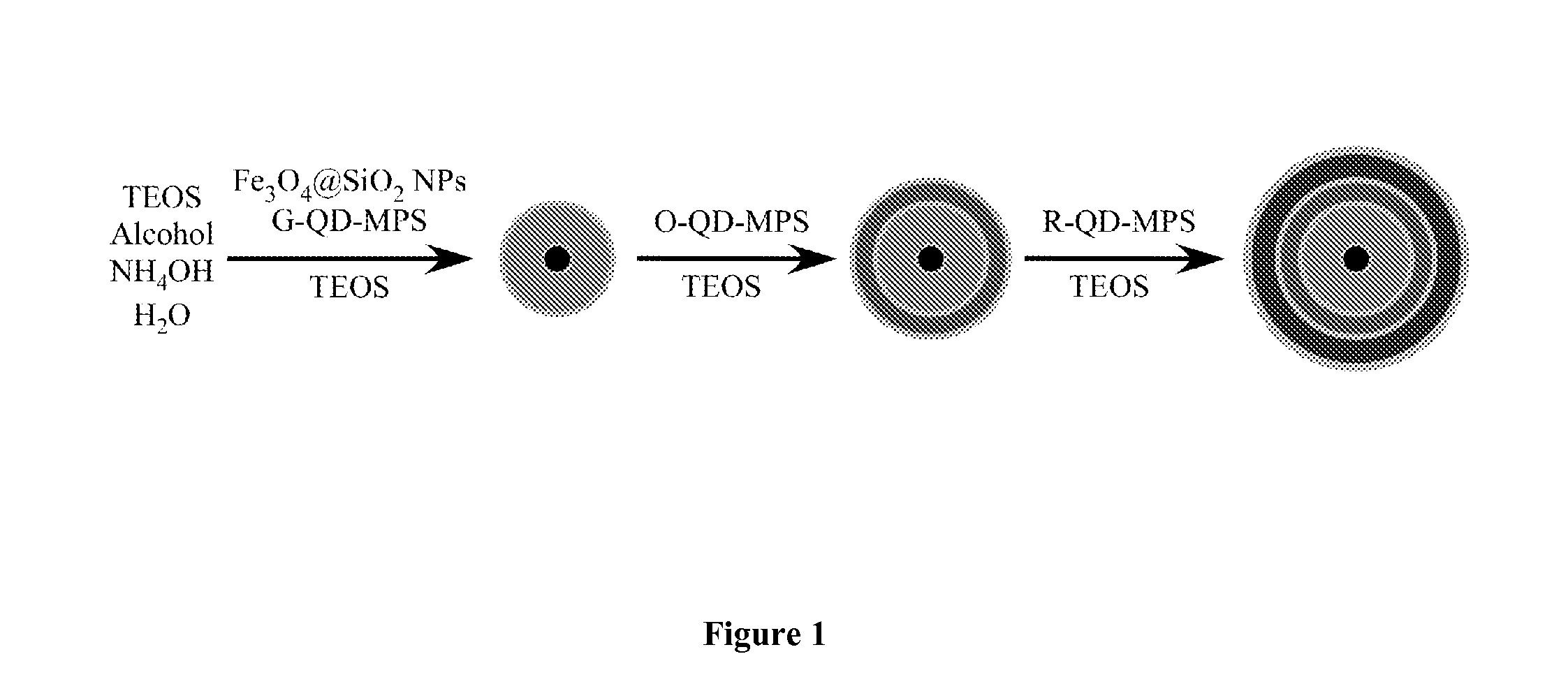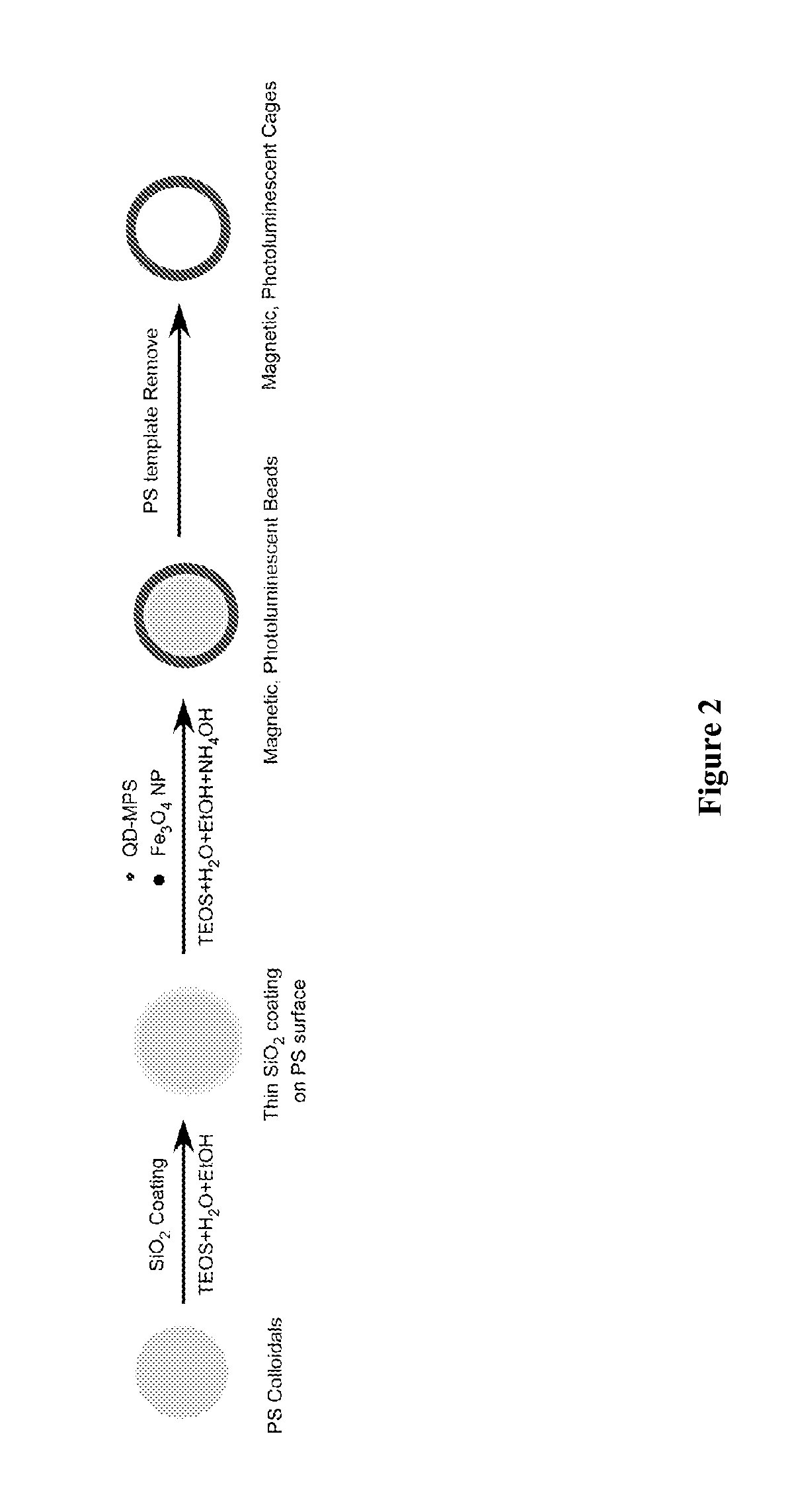Quantum Dot Barcode Structures and Uses Thereof
a barcode and dot technology, applied in the field ofquantum dot barcode structures, can solve the problems of severe limitation on the number of different color organic dye molecules, the need for multifunctional carriers, and the disadvantages of using organic dyes for fluorescent labeling systems
- Summary
- Abstract
- Description
- Claims
- Application Information
AI Technical Summary
Benefits of technology
Problems solved by technology
Method used
Image
Examples
example 1
Superparamagnetic, Fluorescent Barcode Microstructures
[0090]FIG. 1 illustrates one strategy for the layer-by-layer synthesis of the barcode microstructures through combination of QD surface chemistry and sol-gel chemistry, which is based on the inorganic-organic hybrid approach by introducing mercaptopropyl trimethoxysilane (MPS)-capped QDs into silica network through sol-gel chemistry [27, 28]. (ie: capped to help reduce / prevent aggregation within layers). Capping agents can include, but are not limited to any thiol-modified ligands, including MPS, mercaptopropyl acid, and thiol-modified DNA. The MPS-capped CdSe@ZnS-containing microstructures were prepared in two steps based on the original low temperature synthetic method reported by us [28-31]. First, the silica coated Fe3O4 NPs serve as core, and the MPS-capped QDs co-condense with tetraethyl orthosilicate (TEOS) to form the first layer of QD-silica network. Secondly, a spacer layer of pure silica deposits on the outside surface...
example 2
2D Western Blotting
[0108]The microstructures can be used in 2D western blot protein detection. Compared to conventional western blot protein detection, this new technology is multiplexing, more sensitive, higher stability and higher throughput. Compared to conventional 96 well plate based enzyme-linked immunosorbent assay (ELISA), this new technology is more economical with small protein samples and fewer antibodies. Crude proteins are obtained through cell lysis. Two dimensional gel electrophoresis is used to separate proteins, and the proteins are then transferred out of the gel onto a membrane (including but not limited to nitrocellulose). Microstructures (functionalized to bind to antibodies) with specific antibody to different proteins are prepared. The microstructures are immobilized to certain protein on the membrane based on the specific interaction between the antibody on the microstructure surface and the protein antigen. Excited by a UV light, different proteins are rapid...
example 3
Hollow Superparamagnetic, Photoluminescent Structures
[0109]FIG. 2 illustrates one embodiment of the present invention of the process to prepare the hollow microstructure with superparamagnetic, highly photoluminescent properties. In the first step, a thin layer a SiO2 was deposited on a polystyrene (PS) template microsphere surface. The PS template is used here for the purpose of forming the template; in the last step it is dissolved or calcined, which ensures drug (if desired) can be loaded in the hollow core that is left. The conditions for the SiO2 thin layer coating on the PS surface were as follows: 1 g of PS microspheres was dispersed in 30-100 g of alcohol solution with 5% to 25% (v / v) of H2O. With stirring and N2 flow, acid solution was added to adjust the solution pH to 2-3. Next, the silica precursor solution was added and the SiO2 coated polystyrene microsphere was achieved. The prepared SiO2 coated polymer microspheres were purified and dispersed in alcohol solution for ...
PUM
| Property | Measurement | Unit |
|---|---|---|
| Length | aaaaa | aaaaa |
| Thickness | aaaaa | aaaaa |
| Thickness | aaaaa | aaaaa |
Abstract
Description
Claims
Application Information
 Login to View More
Login to View More - R&D
- Intellectual Property
- Life Sciences
- Materials
- Tech Scout
- Unparalleled Data Quality
- Higher Quality Content
- 60% Fewer Hallucinations
Browse by: Latest US Patents, China's latest patents, Technical Efficacy Thesaurus, Application Domain, Technology Topic, Popular Technical Reports.
© 2025 PatSnap. All rights reserved.Legal|Privacy policy|Modern Slavery Act Transparency Statement|Sitemap|About US| Contact US: help@patsnap.com



